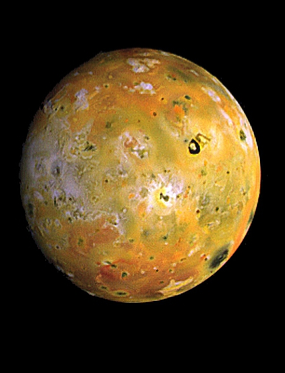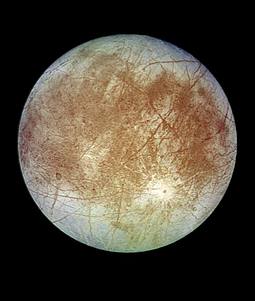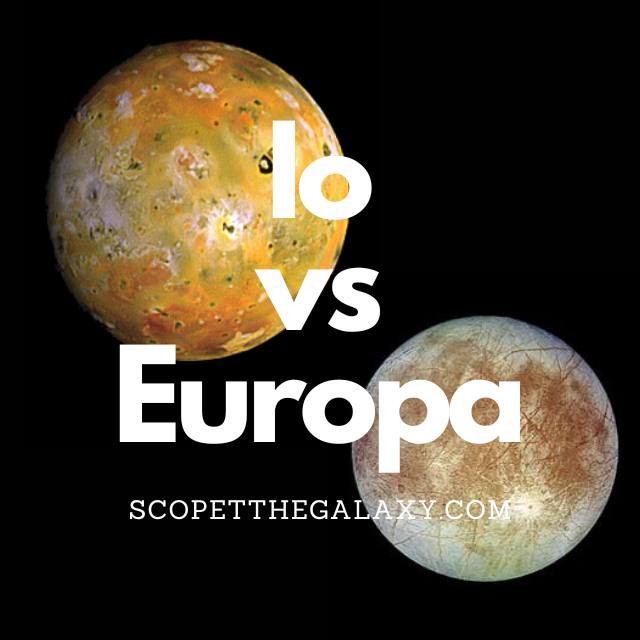*This post may contain affiliate links. This means we may make a commission if you purchase an item using one of our links*
The main differences between Io and Europa are that Io is the most volcanically active entity in our solar system, is the second brightest moon and is the 4th largest moon with a diameter of 3,643km whilst Europa is the brightest moon in our solar system, has water ice on its surface and is the 6th biggest moon with a diameter of 3121.6km.
There are various other differences between the two so, continue reading for a more detailed look at each of these natural satellites along with their similarities and differences below.
What Is The Moon Io?
Table of Contents

The Moon Io – also known as Jupiter I – is the third largest of the Galilean moons, which has the closest orbit to Jupiter. It is the fourth-largest moon in our solar system by size – with a diameter of 3,643km – but has the highest density of all moons in our solar system.
In addition, Io has the strongest surface gravity of all moons and the least water by atomic ratio compared to any other astronomical object in our solar system.
Perhaps the most interesting feature of this lunar body is the 400 active volcanoes on its surface, which make it the most volcanically active object in the solar system; some of these volcanoes can exude plumes of sulfur to a height of several hundred miles.
The reason for this intense activity is the tidal heating caused by friction in the moon’s interior. Thanks to Io’s proximity to Jupiter, it finds itself caught between the gravity of its planet plus the two nearby moons – Ganymede and Europa. And this creates extreme tidal forces.
A side effect of these tidal forces is heat, which keeps most of Io’s crust in liquid form. Because of this, the surface of Io experiences a constant state of renewal; sites once home to large craters are slowly filled with molten lava and liquid rock.
While the complete makeup of Io’s surface is not yet defined, theories suggest that its main component could be sulfur and sulfur compounds because of the varied coloring. Silicate rock could also be a likely component as it would account for the high temperatures.
Io orbits Jupiter from a distance of around 422,000km, with an orbit that takes 42.5 hours to complete. Sitting 778,000,000km from the Sun, the surface temperature of this planet sits around -130 degrees Celsius. But due to the intense volcanic activity, the lava flows can reach temperatures of 1649 degrees Celsius, which is far hotter than anything on Earth.
What Is The Moon Europa?

Europa is the smallest of the Galilean moons, first discovered on 8th January 1610. The surface of this icy world is frozen, but scientists believe a watery ocean could lie beneath the surface. And in 2012, researchers found a possible water plume in the Southern polar region of Europa.
This research is yet to be confirmed; still, it gives us reasonable grounds to hypothesize that water could exist on this icy moon.
Estimates place Europa at around 4.5 billion years old (the same age as its planet, Jupiter), and its average distance from the Sun is approximately 780 million km.
It has a diameter of 3,121.6km, which makes it larger than Pluto but smaller than the Earth’s moon, and the maximum temperature is a chilly -160 degrees Celsius. In regards to mass, it measures in around 4.8 × 10^22 kg.
Europa takes three-and-a-half days to orbit its planet at an average distance of 670,900km, and it is tidally locked, meaning the same side of the moon always faces Jupiter.
Among the fascinating features of this ice moon is its incredibly reflective nature. The icy crust of this body provides a light reflectivity of 0.64 – the highest of any moon in the solar system.
Data from the Galileo spacecraft suggests that Europa is composed of an iron core, rocky mantle, and silicate rock (a similar composition to Earth).
The moon’s surface is covered in cracks, which many theorize could result from tidal currents beneath the surface. It is this potential of water – and of life – that keeps astronomers so interested in this moon.
Europa might be small, but astronomers estimate it holds two to three times more water than the Earth. In addition, this moon possesses the essential elements for life, such as carbon, oxygen, hydrogen, and nitrogen.
There may be no solar energy on this moon, but hydrothermal vents could provide energy, and tidal heating from Jupiter could provide a heat source and keep the moon stable enough for life to form. In addition, the liquid ocean is well protected from radiation from thick, icy surfaces.
Similarities Between Io And Europa
In regards to the similarities between these two moons, they include the following:
- Europa and Io are two of Jupiter’s moons.
- Galileo discovered both Europa and Io in the 17th century.
- They both have a terrestrial based composition.
- Both moons are tidally locked to Jupiter, so the same side always faces toward the planet.
- Neither have a magnetosphere.
- Neither have other moons orbiting them.
- Both obit Jupiter elliptically.
- Both have no rings surrounding them.
Differences Between Io And Europa
As for the differences between the two, they include the below:
- Io is the 4th largest moon whilst Europa is 6th as Io has a diameter of 3,643km whereas Europa has a diameter of 3,121.6km.
- The average temperature on Io is -130 degrees Celsius whilst Europa has a temperature of -160 degrees Celsius.
- Europa has a practically non-existent atmosphere composed mostly of oxygen whilst Io’s atmosphere is also very thin but composed mostly of sulfur dioxide.
- Europa has water ice present on its surface whilst Io is the most volcanically active entity in our solar system.
- Europa is 670,900km away from Jupiter on average whilst Io’s average distance is 442,200km from Jupiter.
- Europa is the most luminous moon in our solar system with a reflectivity 0.64 whilst Io’s reflectivity is just short of it at 0.63.
- Europa’s gravitational strength is 1.315 m/s² whilst Io’s gravity is 1.796 m/s².
- Io has a density of 3.53 g/cm³ whilst Europa’s density is 3.01 g/cm³.
- A day on Io takes 42 hours whilst a day on Europa takes 3.5 days.
- As both satellites are tidally locked to their planet, it takes them both the same as a day to orbit their planet meaning Europa takes 3.55 days and Io completes an orbit in 42 – 43 hours.
- In regards to mass, Europa’s is 4.8 × 10^22 kg whilst Io’s is 8.93 × 10^22 kg.
Summary
Io and Europa have their fair share of similarities from the fact both orbit Jupiter, are denser moons than most others, are tidally locked to their respective planet and orbit it in a elliptical pattern, but they also have their fair share of differences.
Whether it be in regards to mass, size, volcanic activity, the presence of water ice and more, the two are still easy enough to separate as their surface activity is completely unique from one another.


This article names “The Milky Way” twice where it’s supposed to say “solar system”.
Unless you actually meant to say that Io is the most volcanically active moon in the entire Milky Way. Which means you have tech at least 100,000 years more advanced than you’re letting on about. Lol.
Yeah you’re right, it is meant to be solar system, I’ll get that fixed.